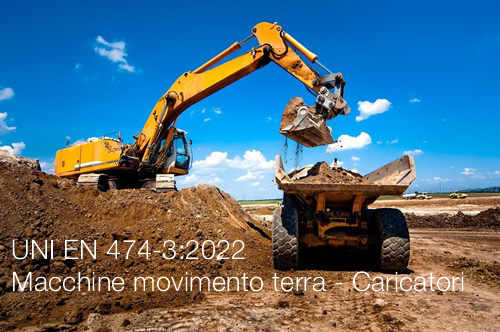CEI 82-25/1:2022

CEI 82-25/1:2022 / Guida alla progettazione, realizzazione e gestione di sistemi di generazione fotovoltaica
ID 17686 | Update news 12.01.2025 / Variante V1 del 03.2024 modifica la classificazione da ...
ID 19705 | 27.05.2023 / In allegato preview
ISO/TR 7015:2023
Ergonomics - The application of ISO/TR 12295, ISO 11226, the ISO 11228 series and ISO/TR 23476 in the construction sector (civil construction)
Date: April 2023
UNI ISO/TR 7015:2024 Ergonomia - L'applicazione di ISO/TR 12295, ISO 11226, della serie ISO 11228 e di ISO/TR 23476 nel settore delle costruzioni (edilizia civile)
_________
This document is intended to be used alongside ISO/TR 12295, ISO 11226, the ISO 11228 series and ISO/TR 23476 in the construction sector.
This document (although the examples shown refer only to the civil construction sector) gives information on how existing standards can be used in a global sector, such as construction. Where biomechanical overload is a relevant aspect, albeit with different characteristics, work-related musculoskeletal disorders (WMSDs) are common and specific preventive actions are needed.
This document is intended to:
1) define the user(s) and fields for its application (including non-experts in ergonomics);
2) provide examples of procedures for hazard identification, risk estimation or evaluation and risk reduction in different agricultural settings, through:
- more synthetic procedural schemes (main test);
- more analytical explanations of the procedures, through mathematical models and application examples, and with the use of specific free simple tools in Annexes A, B and C.
________
Foreword
Introduction
1 Scope
2 Normative references
3 Terms and definitions
4 General outline of work processes in an annual multi-task analysis in civil construction
4.1 General structure of a multi-task analysis
4.2 Study of tasks distribution over the year on groups of workers who are homogeneous in terms of risk exposure
5 First levels: pre-mapping of danger and discomfort through key questions and quick assessment
5.1 Foreword
5.2 The pre-mapping model
6 Analytical study of work processes in annual multi-task analysis: description of a typical working day for each month and quantitative task distribution over the year
6.1 General
6.2 Phase A – Description of a typical working day
6.3 Phase B – Estimation of total number of hours worked every month of the year
6.4 Phase C – Assignment of tasks to a homogeneous group (or individual worker) and calculation of proportional tasks duration in each individual month
7 Annual multi-task risk assessment of biomechanical overload for the upper limbs
7.1 General
7.2 Phase A – Analysis of each individual task using the OCRA checklist to calculate the intrinsic risk score and prepare the tasks basic risk evaluation for each crop
7.3 Phase B – Application of mathematical models and preliminary preparation of artificial working day representative of the whole year and of every month of the same year
8 Annual multi-task risk assessment for working postures
8.1 The meaning of postural tolerance
8.2 Analysing the tolerability of working postures for the spine when performing manual lifting tasks, and for the upper limbs when performing repetitive movements and manual lifting: specific International Stand
8.3 Analysing spinal working postures without manual load lifting and lower limb postures (primarily static)
8.4 The TACOS method: contents and criteria for back and lower limb posture analysis
8.5 Posture analysis of a multi-task job performed on a full-time or part-time basis with yearly job rotation
9 Annual multi-task risk assessment of manual material handling (MMH) and carrying
10 Annual multi-task risk assessment of pushing and pulling
11 Manual material carrying (MMC) risk assessment
12 Conclusions
Annex A Initial identification and preliminary assessment (pre-mapping) of potential risks: criteria and presentation of a specific simple tool that allows its application
A.1 Aim
A.2 General pre-mapping model for civil construction – A facilitated organizational analysis
A.3 Similarities and differences between pre-mapping ERGOCHECK for construction and the classic ERGOCHECK model
A.4 A comparison between the summary of final results for the various homogeneous groups – conclusions
Annex B Criteria and mathematical models for analysing exposure to biomechanical overload in multitask jobs featuring complex macro-cycles (e.g. weekly, monthly, annual turnover)
B.1 Introduction
B.2 Daily job rotation
B.3 Rotations over periods longer than a day: the macro cycle (e.g. weekly, monthly, yearly)
B.4 Conclusions
B.5 Examples of evaluating the final risk in exposure to biomechanical overload
Annex C Criteria to evaluate working postures of the spine and lower limbs using the TACOS strategy in daily or other macro-cycle multi-task analysis: brief presentation
C.1 Preface
C.2 Why a new approach is needed: TACOS method contents and criteria for back and lower limb posture analysis
C.3 Timed score for postures calculation methods in multi-task exposure scenarios
C.4 Conclusions
Bibliography
Preview in attachment
Collegati
ISO/TR 12295 Documento applicativo rischio MMC ISO 11228-X e ISO 11226
Rischio MMC e ISO/TR 12295:2014
Linee indirizzo MMC pazienti ISO TR 12296 (MAPO) | RL
(MMC) Movimentazione manuale dei carichi | UNI ISO 11228-1:2022
UNI ISO 11228-1:2022 - MMC / Sollevamento, abbassamento e trasporto
Valutazione rischio MMC ripetitivi ISO 11228-3 OCRA | Dettagliata
Valutazione rischio MMC ripetitivi ISO 11228-3 OCRA | Semplice
ISO/TR 12295 Documento applicativo rischio MMC ISO 11228-X e ISO 11226

ID 17686 | Update news 12.01.2025 / Variante V1 del 03.2024 modifica la classificazione da ...

Update 31 Gennaio 2020
Legge 1º marzo 1968 n. 186:
"...Tutte le apparecchiature e gli impianti elettrici ed elettronici devono essere costruiti "a regola d'arte"; quelli realizzat...

UNI EN 474-3:2022 Macchine movimento terra - Sicurezza - Parte 3: Requisiti per caricatori
La norma, insieme alla UNI EN 474-1:2022, tratta tutt...
Testata editoriale iscritta al n. 22/2024 del registro periodici della cancelleria del Tribunale di Perugia in data 19.11.2024